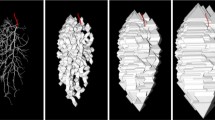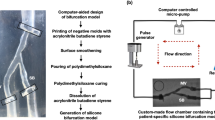Abstract
Early changes in branching geometry of microvasculature and its associated impact on the perfusion distribution in diseases, especially those in which different branching generations are affected differently, require the ability to analyze intact vascular trees over a wide range of scales. Micro-CT offers an excellent framework to analyze the microvascular branching geometry. Such an analysis requires methods to be developed that can accurately characterize branching properties, such as branch diameter, length, branching angle, and branch interconnectivity of the microvasculature. The purpose of this article is to report the results of a study of two human intramyocardial coronary vascular tree casts in which the accuracy of micro-CT vascular imaging and its analysis are tested against measurements made through an optical microscope (used as the “gold-standard”). Methods related to image segmentation of the vascular lumen, vessel tree centerline extraction, individual branch segment measurement, and compensating for the non-ideal modulation transfer function of micro-CT scanners are presented. The extracted centerline accurately characterized the hierarchical structure of the vascular tree casts in terms of “parent–branch” relationships which allowed each interbranch segments’ dimensions to be compared to the optical measurement method. The comparison results show a close to ideal 1:1 relationship for both length and diameter measurements made by the two methods. Combining the results from both specimens, the standard deviation of the difference between measurement methods was 19 μm for the measurement of interbranch segment diameters (ranging from 12 to 769 μm), and 172 μm for the measurement of interbranch segment lengths (ranging from 14 to 3252 μm). These results suggest that our micro-CT image analysis method can be used to characterize a vascular tree’s hierarchical structure, and accurately measure interbranch segment lengths and diameters.












Similar content being viewed by others
References
Altman, D. G., and J. M. Bland. Measurement in medicine: the analysis of method comparison studies. Statistician 32:307–313, 1983.
Au, O. K.-C., C.-L. Tai, H.-K. Chu, D. Cohen-Or, and T.-Y. Lee. Skeleton extraction by mesh contraction. ACM Trans. Graph. 27:1–10, 2008.
Bassingthwaighte, J. B., J. H. G. M. Van Beek, and R. B. King. Fractal branchings: the basis of myocardial flow heterogeneities. Ann. NY Acad. Sci. 591:392–401, 1990.
Cohen, L.D., and R. Kimmel. Global minimum for active contour models: a minimal path approach. Int. J. Comput. Vis. 24:57–78, 1997.
Deschamps, T., and L. D. Cohen. Minimal path in 3D images and application to virtual endoscopy. In: ECCV 2000, Vol. 184, 2000, pp. 543–547.
Eberly, D. and J. Lancaster. On gray scale image measurements. CVGIP: Graph. Mod. Image Proc. 53:538–549, 1991.
Feldkamp, L. A., L. C. Davis, and J. W. Kress. Practical cone-beam algorithm. J. Opt. Soc. Am. A 1:612–619, 1984.
Glover, G. H., and N. J. Pelc. Nonlinear partial volume artifacts in x-ray computed tomography. Med. Phys. 7:238–248, 1980.
Hassouna, M.S. and A.A. Farag. On the extraction of curve skeletons using gradient vector flow. In: 11th IEEE International Conference on Computer Vision, Vol. 2136, 2007, pp. 1–8.
Herman, G. T. Image Reconstruction From Projections. NY: Academic Press, 316 pp, 1980.
Hoffman, K. R., D. P. Nazareth, L. Miskolczi, A. Gopal, Z. Wang, S. Rudin, and D. R. Bednarek. Vessel size measurements in angiograms: a comparison of techniques. Med. Phys. 29:1622–1633, 2002.
Hoogeveen, R., C. Bakker, and M. Viergever. Limits to the accuracy of vessel diameter measurement in MR angiography. J. Magn. Reson. Imaging 8:1228–1235, 1998.
Jorgensen, S. M., O. Demirkaya, and E. L. Ritman. Three-dimensional imaging of vasculature and parenchyma in intact rodent organs with x-ray micro-CT. Am. J. Physiol. Heart. Circ. Physiol. 275:H1103–H1114, 1998.
Kaimovitz, B., Y. Huo, Y. Lanir, G. S. Kassab. Diameter asymmetry of porcine coronary arterial trees: structural and functional implications. Am. J. Physiol. Heart Circ. Physiol. 294:H714–H723, 2008.
Kalsho, G., and G. S. Kassab. Bifurcation asymmetry of the porcine coronary vasculature and its implications on coronary flow heterogeneity. Am. J. Physiol. 287:H2493–H2500, 2004.
Kline, T. L., Y. Dong, M. Zamir, and E. L. Ritman. Erode/dilate analysis of micro-CT images of porcine myocardial microvasculature. Proc. SPIE 7626:762620-1–762620-9, 2010.
Lam, L. and S.-W. Lee. Thinning methodologies—a comprehensive survey. IEEE Trans. Patt. Anal. Mach. Int. 14:869–885, 1992.
Lee, J., P. Beighley, E. Ritman, and N. Smith. Automatic segmentation of 3D micro-CT coronary vascular images. Med. Image Anal. 11:630–647, 2007.
Lee, T.-C., and R. L. Kashyap. Building skeleton models via 3-D medial surface/axis thinning algorithms. CVGIP: Graph. Mod. Image Proc. 56:462-478, 1994.
Lindquist, W. B., S.-M. Lee, D. A. Coker, K. W. Jones, and P. Spanne. Medial axis analysis of three dimensional tomographic images of drill core samples. J. Geophys. Res. 101B:8297, 1996.
Lobregt, S., P. W. Veerbeek, and F. C. Groen. Three-dimensional skeletonization: principle and algorithm. IEEE Trans. Patt. An. Mach. Int. PAMI-2:75–77, 1980.
Marxen, M., J. G. Sled, L. X. Yu, C. Paget, and R. M. Henkelman. Comparing microsphere deposition and flow modeling in 3D vascular trees. Am. J. Physiol. Heart Circ. Physiol. 291:H2136–H2141, 2006.
Megalooikonomou, V., M. Barnathan, D. Kontos, P. R. Bakic, and A. D. A. Maidment. A representation and classification scheme for tree-like structures in medical images: analyzing the branching pattern of ductal trees in x-ray galactograms. IEEE Trans. Med. Imaging 28:487–493, 2009.
Nordsletten, D. A., S. Blackett, M. D. Bentley, E. L. Ritman, and N. P. Smith. Structural morphology of renal vasculature. Am. J. Physiol. Heart Circ. Physiol. 291:H296–H309, 2006.
Op Den Buijs, J., Z. Bajzer, and E. L. Ritman. Branching morphology of the rat hepatic portal vein tree: a micro-CT study. Ann. Biomed. Eng. 34:1420–1428, 2006.
Osher, S., and J. Sethian. Fronts propagating with curvature speed: algorithms based on Hamilton–Jacobi formulations. J. Comput. Phys. 79:12–49, 1988.
Peyré, G., and L. Cohen. Landmark-based geodesic computation for heuristically driven path planning. In: Proceedings of the IEEE International Conference on Computer Vision and Pattern Recognition, 2006, pp. 2229–2236.
Popel, A. S. Network models of peripheral circulation. In: Handbook of Bioengineering, edited by R. Skalak and S. Chien. New York: McGraw-Hill Inc., 1987, pp. 20.1–20.24.
Pries, A. R., T. W. Secomb, and P. Gaehtgens. Relationship between structural and hemodynamic heterogeneity in microvascular networks. Am. J. Physiol. Heart Circ. Physiol. 270:H545–H553, 1996.
Robb, R. A., D. P. Hanson, and M. C. Stacy. ANALYZE: a comprehensive, operator-interactive software package for multidimensional medical image display and analysis. Comput. Med. Imaging Graph. 13:433–454, 1989.
Rouy, E., and A. Tourin. A viscosity solutions approach to shape-from-shading. SIAM J. Numer. Anal. 29:867–884, 1992.
Sato, Y., S. Yamamoto, and S. Tamura. Accurate quantification of small-diameter tubular structures in isotropic CT volume data based on multiscale line filter responses. In: Proceedings of MICCAI’04, Vol. 3216, 2004, pp. 508–515.
Schirmacher, H., M. Zockler, D. Stalling, and H.-C. Hege. Boundary surface shrinking—a continuous approach to 3D center line extraction. In: Imaging Multidimensional Digital Signal Processing, 1998, pp. 25–28.
Sedgewick, R. Algorithms. Reading, MA: Addison-Wesley Publishing Company, 1988, 657 pp.
Sethian, J. Level Set Methods and Fast Marching Methods: Evolving Interfaces in Computational Geometry, Fluid Mechanics, Computer Vision and Materials Science. New York, NY: Cambridge University Press, 1999, 400 pp.
Soltanian-Zadeh, H., A. Shahrokni, and R. A. Zoroofi. Voxel-coding method for quantification of vascular structure from 3D images. Proc. SPIE 4321:263–270, 2001.
Spaan, J. A. E. Coronary Blood Flow. AA Dordrecht, The Netherlands: Kluwer Academic Publishers, 1991, 389 pp.
Sutera, S. P., and R. Skalak. The history of poiseuille’s law. Ann. Rev. Fluid Mech. 25:1–19, 1993.
Suwa, N., and T. Takahashi. Estimation of intravascular blood pressure gradient by mathematical analysis of arterial casts. Tohoku J. Exp. Med. 79:168–198, 1963.
Telea, A., and J. J. van Wijk. An augmented fast marching method for computing skeletons and centerlines. Eurograph. Assoc. (to appear in IEEE TCVG Symposium on Visualization) 22:251–261, 2002.
Tsao, Y. F. and K. S. Fu. A parallel thinning algorithm for 3-D pictures. Comput. Graph. Imaging Process. 17:315–331, 1981.
van Uitert R., and I. Bitter. Subvoxel precise skeletons of volumetric data based on fast marching methods. Med. Phys. 34:627–637, 2007.
Wischgoll, T., J. S. Choy, E. L. Ritman, and G. S. Kassab. Validation of image-based method of extraction of coronary morphometry. Ann. Biomed. Eng. 36:356–368, 2008.
Witt, S. T., C. H. Riedel, M. Goessl, M. S. Chmelik, and E. L. Ritman. Point spread function deconvolution in 3D micro-CT angiography for multiscale vascular tree separation. Proc. SPIE 5030:720–727, 2003.
Yu, K.-C., E. L. Ritman, and W. E. Higgins. System for the analysis and visualization of large 3D anatomical trees. Comput. Biol. Med. 37:1802–1820, 2007.
Zamir, M. Tree structure and branching characteristics of the right coronary artery in a right-dominant human heart. Can. J. Cardiol. 12:593–599, 1996.
Zamir, M. Mechanics of blood supply to the heart: wave reflection effects in a right coronary artery. Proc. R. Soc. Lond. B. 265:439–444, 1998.
Zamir, M. The Physics of Coronary Blood Flow. New York, NY: Springer Science+Business Media Inc., 2005.
Zamir, M., and N. Brown. Arterial branching in various parts of the cardiovascular system. Am. J. Anat. 163:295–307, 1982.
Zamir, M., and H. Chee. Segment analysis of human coronary arteries. Blood Vessels 24:76–84, 1987.
Acknowledgments
The authors would like to thank Mr. Steven M. Jorgensen for scanning the specimens, Mr. Andrew J. Vercnocke for performing image reconstructions, and Ms. Delories C. Darling for her help in the preparation of this manuscript. We would also like to thank the anonymous reviewers for their helpful suggestions. This study was supported in part by NIH Grant EB000305, and The Mayo Foundation. The hand measurements and schematic diagrams, as well as the micro-CT image volumes of specimens h61 and r14 have been made available through our website (Phenoscope), http://www.mayoresearch.mayo.edu/pirl.
Author information
Authors and Affiliations
Corresponding author
Additional information
Associate Editor Larry V. McIntire oversaw the review of this article.
Rights and permissions
About this article
Cite this article
Kline, T.L., Zamir, M. & Ritman, E.L. Accuracy of Microvascular Measurements Obtained From Micro-CT Images. Ann Biomed Eng 38, 2851–2864 (2010). https://doi.org/10.1007/s10439-010-0058-7
Received:
Accepted:
Published:
Issue Date:
DOI: https://doi.org/10.1007/s10439-010-0058-7




